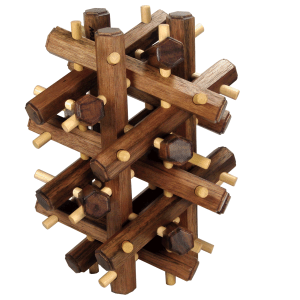LT – Lateral Thinking
22 August 2002Edward Hordern IPP22 Puzzle Exchange – Antwerp, Belgium. August 2002. 340 made. Presented by Brian Young. Made by Mr Puzzle Australia. Designed by Brian Young.…


Stewart Coffin wrote in “Geometric Puzzle Design” that assembling a cluster of separate hexagonal sticks and dowels can be a puzzle but a more difficult and therefore more interesting puzzle will be made when some of the hexagonal sticks and dowels are joined to make elbow-shaped pieces. The more elbows the harder the puzzle. Stewart theorised that the maximum number of elbows that can be joined before assembly becomes impossible is half the number of each type of piece, so that’s what Brian has done.
18 hexagonal sticks of varying lengths 18 dowels of varying lengths 9 hexagonal sticks and dowels joined to make elbows Numbered as #22-B in Stewart Coffins numbering system his notes indicate at first that he thought he had only made one puzzle in 1985. Later research would indicate that just two puzzles were ever made back in 1989 and no mention is made of how many elbows, or therefore the level of difficulty, of these.
Stewart noted that the lattice structure repeats itself indefinitely in all directions, so it would be possible to make larger assemblies with more and longer sticks and dowels. But in reality it’s not much help if you look at Stewart’s notes; Brian has built the puzzle in the reverse direction to Stewart’s drawings, after all, we are downunder.
The hexagonal pieces are made from Papua New Guinean Ebony. Whilst African Ebony is almost all black as you travel eastward around the globe the solid black reduces so by the time you come to the Pacific region the wood is a reddish brown with very prominent jet black streaks. The dowel is made from Ramon wood.
Size: 220mm x 170mm x 170mm The hexagonal sticks are made from 20mm x 20mm stock. This puzzle is so difficult we decided to provide a printed solution.